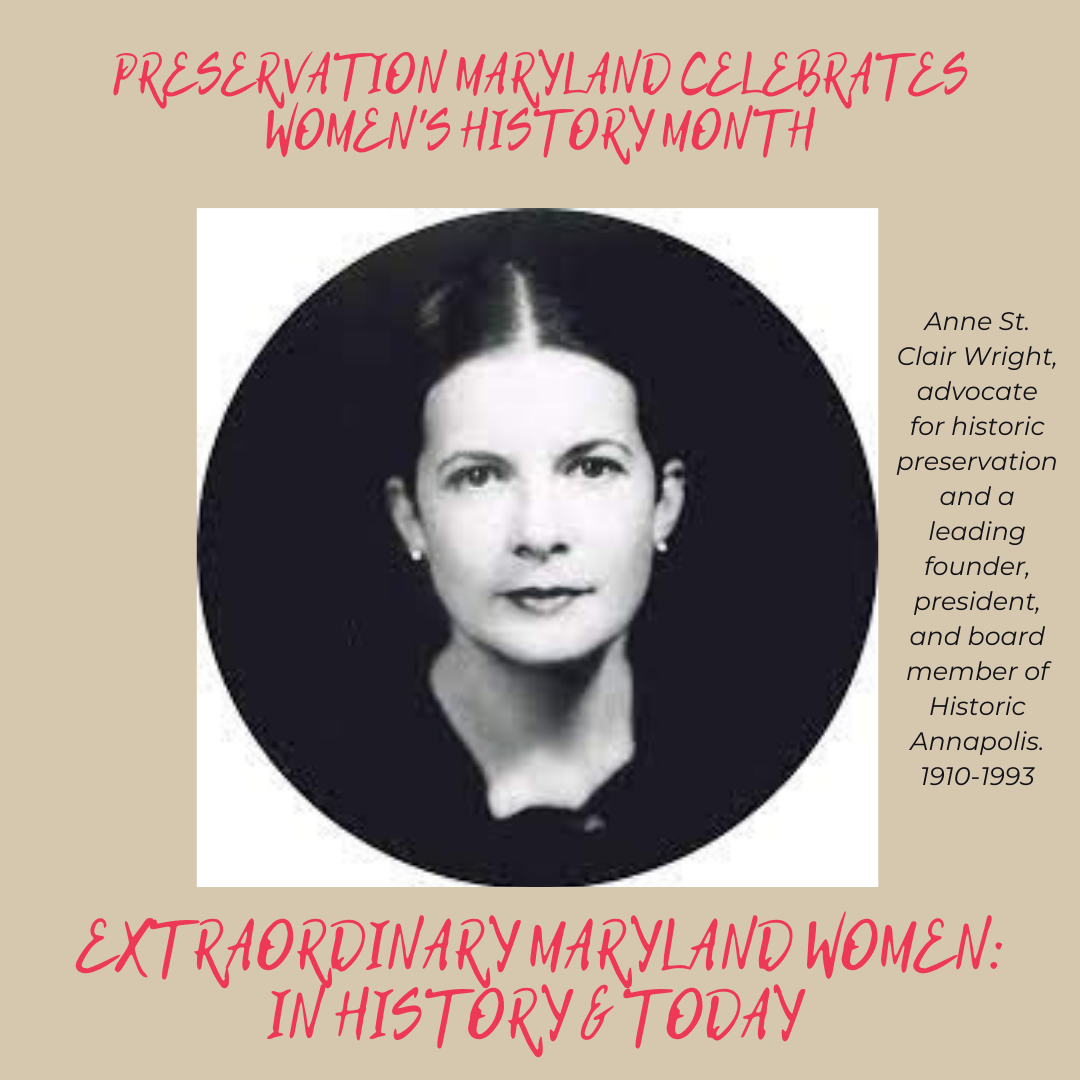March is Women’s History Month, commemorating and encouraging the study, observance, and celebration of the vital role of women in American history. This month Preservation Maryland will be sharing the inspiring stories of Maryland women – both in our history and women of today – and their impact on preservation, in our communities, the state, and across the country. Today we bring you the story of Anne St. Clair Wright, advocate for historic preservation and a leading founder, president, and board member of Historic Annapolis Incorporated, an organization that fought to maintain, preserve, and restore the downtown historic district in the city of Annapolis.
Visit us here on the blog every Tuesday and Thursday in March for more extraordinary women in Maryland.
Wright was born in Newport News, Virginia in 1910 to U.S. Naval Officer Arthur St. Clair Smith and Anna Lena Salley Smith. Due to her father’s position as an officer in the U.S. Navy, Anne spent her childhood abroad. She lived in the Philippines, France, Beijing, Japan, Panama, and finally, in Annapolis, Maryland. While Wright attended school internationally at the Peking American School in Beijing, she later went on to study and graduate from Mary Baldwin College in Virginia, and the Maryland Institute of Fine Arts in Baltimore. In 1975, she would go on to receive an honorary doctoral degree from Towson State University for preservation. She received her second honorary doctorate degree from the University of Maryland for public service in 1985. In 1932, she married Joseph Martin Pickett Wright, a U.S. Naval officer working in Panama. Anne and Joseph formally settled in Annapolis in 1953 when Joseph retired from his service in the Navy.
Wright’s advocacy work began in Annapolis when Joseph was stationed at the Naval Academy in 1948.
Her first effort of preservation was to beautify and maintain the public space and landscaping at the Naval Academy alongside other spouses of Navy servicemembers. Historic Annapolis Incorporated began as a volunteer-run and donation-funded grassroots preservation organization in 1952. Under the leadership of Wright, the organization largely utilized a revolving fund and adaptive reuse style approach to historic preservation. Throughout Wright’s time at the organization, she worked on the restoration and preservation of historic places and structures, including the home of Charles Carroll the Barrister, the Shiplap House, Middleton Tavern, Annapolis Market House, and Paca House and Garden.
Historic Annapolis Incorporated also preserved a selection of historic streets in Annapolis including 4 & 43 Pinkney Street, 77 Main Street, and 37 Cornhill Street. In 1969, the organization launched its notable Historic Building Marker program to provide education and historical awareness to the general public. The organization also proposed instrumental construction limitations on the Gotts Court Parking Facility, and supported the Annapolis City Council’s passage of a Height and Bulk Ordinance and Demolition by Neglect Ordinance. In the years leading up to the 1970s, government funding for preservation initiatives became more widely accessible for preservation organizations like Historic Annapolis Incorporated.
During these years of expansion for the organization, downtown Annapolis was officially placed on the National Register of Historic Places and dedicated as a historic district by United States Secretary of the Interior Stuart Undall in October of 1966, the same year the National Historic Preservation Act was signed into law under President Lydon B. Johnson.
Among the countless awards Wright received for her work in historic preservation, she was also awarded The National Trust’s highest award for historic preservation, the Louise duPont Crowninshield Award. Wright served four terms as the President of Historic Annapolis Incorporated as well as Chair and Chair Emeritus of the Board and spokesperson for the organization throughout 1952 to 1987.
Anne St. Clair Wright was known for continuing her work as ardent preservationist up until her death in 1993. Her many preservation victories to preserve and restore historic Annapolis are visible today, and continue to inspire the work of Historic Annapolis Incorporated, now a thriving preservation organization known simply as “Historic Annapolis.”
RELATED: Read More About Our Historic Property Redevelopment Project in Annapolis

